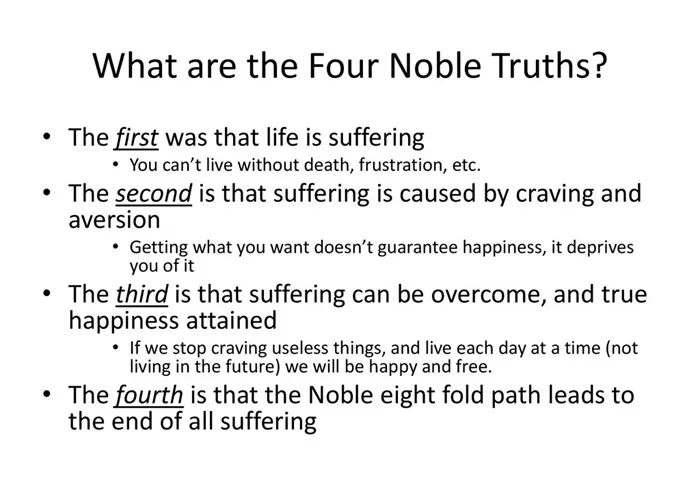The Four Noble Truths are the foundation of Buddhism. They teach us about suffering and how to end it. Understanding and practicing these truths help us find peace and happiness. The four noble truths meaning is simple but deep. By following them, we can improve our life step by step.
What Are the Four Noble Truths?
The Four Noble Truths were first taught by the Buddha after his enlightenment. They explain why people suffer and how to stop suffering. These truths are:
1. The Truth of Suffering (Dukkha)
Life has suffering. We experience pain, loss, sickness, and death. Even happiness can cause suffering because it does not last. This truth teaches us to accept that suffering is part of life.
2. The Truth of the Cause of Suffering
Suffering comes from desire and attachment. We want things to be different, and we hold on to things we like. This craving causes frustration and unhappiness.
3. The Truth of the End of Suffering
It is possible to end suffering. When we stop craving and attachment, suffering stops too. This state of freedom is called Nirvana.
4. The Truth of the Path Leading to the End of Suffering
The way to end suffering is by following the Eightfold Path. This path guides us to live wisely and kindly.
How to Practice the Four Noble Truths
Practicing the Four Noble Truths means living with awareness and intention. Below are steps to help you practice them daily.
Practice 1: Recognize Suffering in Your Life
Start by noticing where you feel pain or discomfort. It can be physical or emotional. Accepting suffering without denial is the first step. Do not avoid difficult feelings but observe them calmly.
Practice 2: Understand What Causes Your Suffering
Look deeply into your desires and attachments. Ask yourself: What am I holding on to? What do I want that I don’t have? This reflection helps you see the roots of your pain.
Practice 3: Let Go of Craving and Attachments
Practice releasing your attachments gently. You can do this by reminding yourself that everything changes. Meditation helps you see clearly and calm your mind. When you let go, you free yourself from suffering.
Practice 4: Follow the Path of Wisdom and Compassion
The Buddha’s Eightfold Path is a guide. It includes:
- Right View: See things as they truly are.
- Right Intention: Have kind and honest thoughts.
- Right Speech: Speak truthfully and kindly.
- Right Action: Act with kindness and respect.
- Right Livelihood: Choose work that does not harm others.
- Right Effort: Work to improve your mind.
- Right Mindfulness: Be aware of your body, feelings, and thoughts.
- Right Concentration: Practice meditation to focus your mind.
By following these steps, you practice the Four Noble Truths in daily life.
Deepening Your Practice
Use Meditation to Understand Suffering
Meditation helps calm the mind and see things clearly. When you sit quietly and watch your breath, you learn to observe suffering without reacting. This builds wisdom and peace.
Apply Mindfulness Throughout the Day
Mindfulness means paying full attention to the present moment. When you eat, walk, or talk, be fully there. Mindfulness helps you notice cravings and attachments as they arise. This awareness makes it easier to let them go.
Practice Compassion for Yourself and Others
Suffering is common to all beings. When you understand your own pain, it becomes natural to care for others. Compassion softens the heart and reduces selfish desires. This kindness supports your practice of the Four Noble Truths.
The Four Noble Truths Symbol and Its Meaning
The four noble truths symbol often appears as a wheel, called the Dharmachakra or Wheel of Dharma. The wheel’s eight spokes represent the Eightfold Path. The circle shows the endless cycle of suffering and rebirth. Practicing the Four Noble Truths helps turn the wheel toward freedom and peace.
Common Challenges in Practicing the Four Noble Truths
Facing Denial of Suffering
Many people avoid facing suffering. It can be painful to accept. Remember that acceptance does not mean giving up. It means seeing clearly so you can heal.
Letting Go of Deep Attachments
Attachments can be strong. They might be habits, relationships, or material things. Letting go takes patience and kindness toward yourself. Practice little by little.
Maintaining Consistent Practice
Life is busy, and it’s easy to forget mindfulness. Try setting reminders or joining a meditation group. Support from others helps keep your practice steady.
Benefits of Practicing the Four Noble Truths
When practiced sincerely, the Four Noble Truths bring many benefits:
- Less suffering and more peace
- Greater clarity and wisdom
- More compassion for yourself and others
- Improved relationships
- Deeper happiness that does not depend on external things
Conclusion
The Four Noble Truths are not just ideas but a path to live by. By recognizing suffering, understanding its causes, letting go, and following the right path, we find true freedom. This practice takes time and patience, but it is worth it. Each small step brings us closer to peace.

